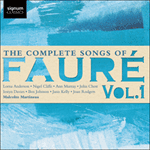The 6/8 rhythm sounds like a waltz to the innocent ear; there is a catchiness to this music and a very Parisian atmosphere. Of all Fauré’s mélodies it is this which most captures a mood of popular song. There is a touch of Poulencian cross-over here (one thinks of that composer’s
La grenouillère) but
Tristesse was written some twenty, or even thirty, years too early for any link with cabaret to be intentional. Nevertheless, one might easily imagine an accordion accompaniment, the refrain which ends each strophe (‘Hélas! j’ai dans le cœur une tristesse affreuse’) sung by Trénet or Piaf, the guttural ‘r’ in ‘affreuse’ rolled deep in the throat. Nectoux refers to the ‘painful melodrama’ of this phrase, and it is true that music like this, relentlessly accented by the down-beats of the accompaniment, falls short of the Fauréan ideal of understatement and restraint. The poem’s provenance is exalted – Gautier’s seminal
La comédie de la mort (1838), a work which pre-dates the grands boulevards which the words seem to describe, and also the source of Berlioz’s
Les nuits d’été. It is thus a surprise to find the composer treating the prosody with such casualness: one need go no further than the very first word (‘Avril’) to encounter the musical accent on the first, rather than the second, syllable. This displacement further creates an impression of Parisian nonchalance, as do references to drinkers with their ‘chansons vermeilles’, and girls in ‘scanty white dresses’. Fauré again gets away with the introduction of the word ‘chien’ into his music.
from notes by Graham Johnson © 2005
Le rythme à 6/8 sonne comme une valse à l’oreille innocente; cette musique accrocheuse exhale une ambiance toute parisienne. De toutes les mélodies de Fauré, elle est celle qui saisit le mieux l’humeur de la chanson populaire, avec une touche de «cross-over» poulencquien (on pense à
La grenouillère), même si elle fut écrite vingt ou trente ans trop tôt pour qu’on puisse voir là un quelconque lien intentionnel avec le cabaret. On n’en imagine pas moins sans peine un accompagnement à l’accordéon, le refrain de chaque fin de strophe («Hélas! J’ai dans le cœur une tristesse affreuse») chanté par Trénet ou Piaf, avec le guttural «r» d’«affreuse» roulé bien au fond de la gorge. Nectoux évoque le «mélodrame douloureux» de cette phrase, et il est vrai qu’une telle musique, implacablement accentuée par les temps forts de l’accompagnement, ne correspond guère à l’idéal fauréen de retenue et de modération. Ce poème émane d’une source de la plus belle eau: le fondamental
La comédie de la mort (1838) de Gautier, une œuvre antérieure aux grands boulevards que les mots semblent décrire, également à l’origine des
Nuits d’été de Berlioz. Quelle n’est donc notre surprise de voir Fauré traiter la prosodie avec pareille désinvolture: dès le tout premier mot («Avril»), l’accent musical porte sur la première, et non sur la deuxième syllabe. Ce déplacement renforce l’impression de nonchalance parisienne, qu’amplifient également les références aux buveurs et à leurs «chansons vermeilles», mais aussi aux demoiselles en «déshabillé blanc». Pour la seconde fois dans ce disque, Fauré s’en va sur l’introduction du mot «chien» dans sa musique.
extrait des notes rédigées par Graham Johnson © 2005
Français: Hypérion


 Fauré: The Complete Songs, Vol. 1
Fauré: The Complete Songs, Vol. 1
